Of the names of the 248 communities and neighbourhoods that have been identified to date in Greater Halifax, 72 (29.0%) can be found as place names in Scotland or are based on Scottish family names. Of course, some of these names are used in other parts of the British Isles as well, but at least 31 of them (12.5%) appear to be unique to Scotland.
Communities and neighbourhoods with names that occur only in Scotland and not elsewhere in the British Isles, and/or are definitely, or most probably, of Scottish origin are:

For comparability with other cities around the world, Greater Halifax has been defined as those urban and semi-urban parts of Halifax Regional Municipality centred on Halifax, Dartmouth and Bedford and their respective outlying commuter communities. This includes the entire Chebucto Peninsula in the south, the Pockwock Lake area in the west, Wellington and Halifax International Airport in the north and the Porter's Lake area in the east.
- Bel Ayr Park - the spelling of this neighbourhood's name suggests a definite Scottish touch to what would normally be Bel Air. Ayr is a town in the south-west of Scotland. The illustration shows the pavilion near the beach at Ayr.
- Burnside and Burnside Park - Burnside is commonly found as a place name in Scotland (two places in Angus and one place in each of Fife, Moray, South Lanarkshire and West Lothian). Burn is the Scots word for a stream or creek.
- Cow Bay - According to the Destination Nova Scotia website, this community was named after Robert Cowie who, with Roger Hill, received a land grant in the area in 1763. Cowie is a Scottish surname (see Cowie Hill below).
- Cowie Hill - there is a Cowieshill in Aberdeenshire. Cowie is also a Scottish surname - in Aberdeenshire it is pronounced "Cooie". The article on Cowie Hill retrieved from Wikipedia in March 2007 attributes the name to one of the original owners of the land, Robert Cowie (see also Cow Bay above), and notes that the hill on which the community is situated was originally called "Cowie's Hill". Robert Cowie was a British merchant (presumably of Scottish ancestry), who was granted the land in 1752 by Governor Edward Cornwallis.
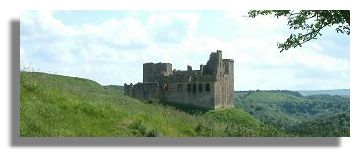
- Crichton Park - the name of this suburb could well be attributed to Crichton in Midlothian, the location of Crichton Castle (seen here) where Mary Queen of Scots married Lord Darnley in 1565. She later married the Earl of Bothwell, owner of Crichton Castle, and lost her crown as a result.
- Duncan's Cove - although there are no places in Scotland with this name, Duncan is an ancient Scottish family name. The Duncan clan is descended from the medieval earls of Atholl, the name being an anglicisation of Donnachadh, from Gaelic donn (brown) and cath (war), thus suggesting the meaning 'brown warrior'. According to the Halifax County Genweb site, the name of this community honours Admiral Duncan who defeated the Dutch in the naval battle of Camperdown off the Dutch coast in 1797 during the French Revolutionary Wars. Adam Duncan, 1st Viscount Duncan of Camperdown (1731-1804) was born in Lundie, Angus, Scotland and educated in Dundee.
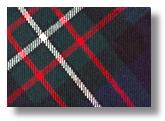
- Ferguson's Cove - Ferguson is definitely a Scottish name. The Ferguson clan has numerous branches, the name meaning 'first choice' in Gaelic. The following is a quote from the Destination Nova Scotia website: "Settled in 1788, it was first known as Falkland after Lady Falkland, wife of Lucius Bentinck Falkland, one of the Lieutenant Governors of Nova Scotia at the time. Its present name may refer to an early settler." (Destination Nova Scotia)
- Glen Margaret - The Halifax County Genweb site provides the following explanation of the origin of the name of this community: "As the name suggests, Scottish Loyalists first settled the community of Glen Margaret. This district was first known as Lower Ward. It was changed to Glen Margaret in honour of the wife of John Fraser, one of the early Scottish Loyalist settlers." It is also stated that "Among the early Scottish settlers were John Creighton, Alexander and Hugh MacDonald and Donald Patterson. Other Loyalists with such names as Renfrew, Moore, Marven, Redmond and Munroe also settled here."
- Glen Moir - the Moirs are a sept of Clan Gordon. One presumes that this Bedford suburb was named for the Moirs who ran a family business in Halifax manufacturing bakery products. In 1873, James Moir, a son of William Moir, added confectionery goods to the family business. Part of the Moirs Mill factory was later moved to Bedford (Halifax County Genweb site).
- Glengarry Gardens - This neighbourhood, in the Timberlea area, was probably named for the well-known glen in Inverness-shire west of Loch Ness, in the Scottish Highlands, either directly or indirectly through other places in Canada called Glengarry.
- Grahams Corner - there are many places in central and southern Scotland beginning with Graham from the surname; also a few just over the border in Northumberland and Cumbria. Graham is a Scottish family name, the clan being descendants of an Anglo-Norman family that settled in Scotland (particularly the border areas) in the early part of the 12th century. As noted by Scarlett (1975, p. 69), "in 1606 an entire sept of Cumberland Grahams was "transported" to Roscommon in Ireland for being troublesome on the Border." The most famous bearer of the name was the brilliant soldier James Graham, the 1st Marquess of Montrose (1612-50).
- Haliburton Hills and Haliburton Heights - the Ancestry.com website suggests that Haliburton is a Scottish family name from Berwickshire. Census data for 1891 supplied by Ancestry.com shows the wide distribution of the name across both southern and central Scotland and northern England while it is perhaps relevant to note that that the spelling variation Halliburton occurred mainly in the far north of England, i.e., those counties closest to Berwickshire. Information on the history of these Halifax neighbourhoods in the Hammonds Plains/Tantallon area has not been found. Most of the streets have English names (Dundee Street and Edinborough Court being the exceptions) while the local lake has the intriguing name 'Land of Laziness Lake.' One wonders whether the names of these neighbourhoods are a tribute to the author Thomas Charles Haliburton (1796-1865), or his father, the lawyer and politician William Hersey Otis Haliburton (1767-1829), both of whom were born in Windsor, Nova Scotia of New England stock (Dictionary of Canadian Biography Online).
- Harrietsfield (Scottish Borders). The origin of the name of this community is uncertain with the result that it is not necessarily Scottish. "The community was probably named for the wife of Colonel William Thompson who was living in the area by the 1780s" (Halifax County Genweb site). Thompson (often spelled Thomson in Scotland) is a Scottish and English family name.
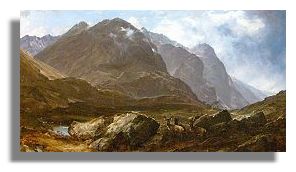
- Highland Acres and Highland Park - both possibly recalling the Highlands of Scotland. The illustration shows a painting of Glen Coe in the Highlands.
- Lochview Road - there is a Lochview in North Lanarkshire as well as many guesthouses and hotels in Scotland with this descriptive name ('view of the loch'). Most of the streets in the neighbourhood of Lochview Road have Scottish names.
- McGraths Cove - although there is no place in Scotland by this name, McGrath is a Scottish family name, the MacGraths being a sept of Clan Macrae. According to the House of Names heraldic website, McGrath is also an Irish family name. According to Brown (1922), an authority on place names in Nova Scotia, McGraths Cove was named after a William McGrath, who settled in the area in the 1851.
- McNabs Island - the MacNabs are an ancient clan descended from the abbots of Glendochart, at the western end of Loch Tay. The Destination Nova Scotia website provides the following brief history of the island: "There is evidence that the French first surveyed MacNab's Island as early as 1711, building rudimentary fortifications on the island and naming it 'Ils de Chibouquetou.' Within twenty-one years, it was known as Scarborough Island, then Cornwallis Island in honour of Edward Cornwallis after the founding of Halifax in 1749. The Mi'kmaq used the island as a summer camp until approximately 1760, although the land had been given to Governor Cornwallis' brothers as part of a land grant in 1752. The Cornwallis brothers never lived there, however, and in 1783, Peter MacNab purchased the island from the Cornwallis family. A native of Scotland he was a prominent Halifax ship owner and merchant who had served in the British Army during the American Revolution." (Destination Nova Scotia).
- Melville Cove - there is a Melville House in Fife and Melville Grange and Melville Mains in Midlothian. Melville is also a Scottish family name originally from Dumfries-shire. Melville Cove, like Melville Island in the Northwest Arm of Halifax Harbour, was named in honour of Henry Dundas, Viscount Melville, a Scottish lawyer and Tory politician who had been appointed First Lord of the Admiralty in 1804.
- Port Wallace and Wallace Heights - there are many places in Scotland based on the Scottish surname of Wallace, examples being Wallaceton in Dumfries & Galloway, Wallacetown in South Ayrshire and Wallacestone in Falkirk. One of Scotland's most famous Wallaces is Sir William Wallace, the 13th century patriot who championed Scotland's independence when this was under threat by King Edward I of England's expansionist policy. Wallace means 'Welshman', a Saxon term for 'foreigner' that was applied by the Saxons to the descendants of the Celtic-speaking Ancient Britons in Wales, Cornwall, Cumbria and Strathclyde. The article on Port Wallace, Nova Scotia, retrieved from Wikipedia in February, 2009 provides the following account of the origin of the name: "Port Wallace was established in 1861 and is named after the Honourable Michael Wallace, a colonial administrator and former President of the Shubenacadie Canal Company." In the Wikipedia article it is later stated that "Admiral Provost Wallis, Royal Navy was stationed at North American Station at some time after Michael Wallace's death. Upon the death of Admiral Wallis in 1891, the spelling of the community was erroneously changed to 'Port Wallis' and this was officially approved on 3 December 1953, only to be reverted to the present 'Port Wallace' on 18 February 1963."
- Seaforth - there is a Seaforth Island and Loch Seaforth in the Western Isles and one of the most famous Scottish regiments was the Seaforth Highlanders, raised by the restored Earl of Seaforth in 1778. Seaforth is also the name of a well-known suburb of Liverpool, England at the mouth of the river Mersey, the name having been taken there from Scotland in the 19th century by Sir John Gladstone, the father of British Prime Minister William Ewert Gladstone.
- Southdale (Shetland Islands).
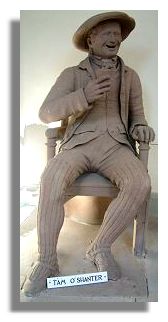
- Tam O'Shanter Ridge - Tam O'Shanter is Robert Burns' most famous narrative poem about the problems of bumping into witches at Halloween, particularly when under the influence of drink! All the streets in this neighbourhood have Scottish names, its main road being Caledonia Road. The streets are named Aberdeen Court, Berncray Avenue, Cairndow Drive, Culrain Crescent, Dumbarton Avenue, Dunrobin Drive, Glencoe Drive, Gourok Avenue, Greenoch Drive, Inverary Drive, Kincardine Drive, Montrose Crescent, Orkney Drive, Perth Drive, Rannoch Road, Strath Lane, Tobermory Road and Tummell Drive. One wonders whether Berncray Avenue is a corruption of Berneray, one of the islands in the Outer Hebrides. Gourok and Tummell also seem to be misspellings (Gourock and Tummel in Scotland).
- Tantallon, Tantallon Woods and Upper Tantallon (Tantallon Castle in East Lothian). "The present name is after the famous stronghold of the Douglas Family in Haddingtonshire, Scotland." (Brown, 1922). Some additional comments can be found in the Destination Nova Scotia website: "The area was once a part of French Village, which explains why the area's former train-station, now a gift shop, retains that name. The community became Tantallon sometime in the early 1900s, most likely named for the Scottish stronghold of the Douglas family which was called Tantallon." (Destination Nova Scotia).
- Waterstone (West Lothian).
- Waverley (Waverley railway station, Edinburgh and the title of Sir Walter Scott's first novel) but also the name of several places in England, including Waverley Abbey in Surrey, the inspiration for the title of Sir Walter's novel. The article on Waverley, Nova Scotia, retrieved from Wikipedia in March 2007, states that Waverley was indeed named after Sir Walter's Waverley novels. A fuller explanation of the origin of the name is provided in the Destination Nova Scotia website, which also notes that the community was known earlier as Germantown: "The community actually owes its name to Charles P. Allen's love of the literary prose of Sir Walter Scott. One of the earliest residents in the area, Allen named his cottage 'Waverley' after the title of one of Scott's novels." (Destination Nova Scotia)
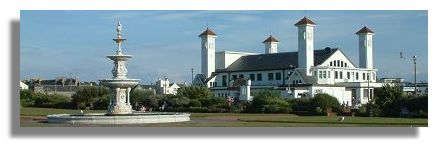
Some of the following communities and subdivisions are also likely to have a direct or indirect Scottish connection, but these names can be found in other parts of the British Isles as well:
- Beechwood Park - there is a Beechwood in Scottish Borders, Dumfries & Galloway and Highland but places called Beechwood are found more frequently in England and are also found in Ireland and Wales. Beechwood Park is probably a purely descriptive name with no intended reference to any particular place in the British Isles.
- Clayton Park - there is a Clayton in Fife. However, this name is far more commonly used in England. According to the article on Clayton Park, Nova Scotia, retrieved from Wikipedia in March 2007, the community "is named after a family that owned property in the area extending up the southern slope of Geizer's Hill." Clayton is an English family name, which reduces the likelihood of a Scottish connection.
- Fletchers Lake - Fletcher is certainly a Scottish family name; there is a Fletcher tartan and there is also a Fletcherfield in Angus possibly associated with the Fletchers of Innerpeffer. Since the origin of the name is purely occupational (meaning arrow-maker) it is hardly surprising that Fletcher is also found as an element in at least twelve place names throughout England, for example Fletchersbridge in Cornwall and Fletcher's Combe in Devon. The community of Fletchers Lake takes its name from property owned by Robert Fletcher at the northern end of Lake Fletcher (information received in December 2008 from Darlene Morrison). It is not known whether Robert Fletcher's ancestry was Scottish.
- Glen Haven - there are places simply called Glen in Dumfries & Galloway, East Ayrshire, North Ayrshire, Orkney Islands and Shetland Islands, as well as two places in Ireland. In addition, there are hundreds of places in both Scotland and Ireland and a few in England and Wales with Glen as an element in the name. Glen means 'valley' in Gaelic. The name of this community appears to have been made up "to reflect the natural beauty of the area" and was the result of a petition organised around 1900 by Gordon Hubley to create a separate community with its own name and its own post office (Halifax County Genweb site).
- Greenhead Road - Greenhead is a suburb of the town of Wishaw in North Lanarkshire. Being a descriptive name, however, it can also be found in England (there are streets in Huddersfield, Yorkshire, for instance called Greenhead Avenue and Greenhead Lane).
- Greenwood Heights - there is a Greenwood in Scottish Borders, Moray and South Lanarkshire but Greenwood is also found in England and in County Mayo, Ireland.
- Highfield Park - there are many places in Scotland called Highfield - in Aberdeenshire, Argyll & Bute, East Ayrshire, East Lothian, Highland, North Ayrshire, South Ayrshire and South Lanarkshire. However, the name is used even more frequently in England.
- Kingswood (Perth & Kinross) but the name is found far more commonly in England and is also found in Ireland and Wales.
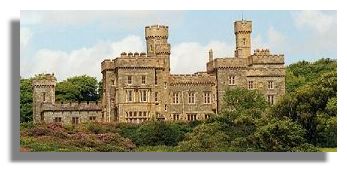
- Lewis Lake (Lewis in the Outer Hebrides). Lewis is a Scottish family name, but it is also a common Welsh family name, and can be found as an element in place names in England and Ireland as well. The illustration shows Lewis Castle on the Isle of Lewis. "It is speculated that Lewis Lake was probably named for an early settler." (Destination Nova Scotia).
- Lucasville - Lucas does not occur in place names in Scotland but is found in England. The Scottish Lucas family is nevertheless a sept of Clan Lamont. The name of this community near Middle Sackville is attributed to James Lucas (Locas), an early pioneer (Halifax County Genweb site), whose ancestry has not been reported. "Settled by Americans named James Lucas, Oliver and Dishna. It was first known as Lucas Settlement. A church was built in 1819, and since that date the place has been known as Lucasville." (Brown, 1922)
- Old Holland Road - there is a place called Holland in the Orkney Islands as well as in three English counties. Holland is an Old English name meaning 'land of hill spurs', though it may also refer, of course, to the Dutch province of Holland. The Halifax neighbourhood takes its name from the road, which in turn was named after William and Thomas Holland, who held a land grant in the area in 1817 (information received in November 2008 from Jean Murray, a descendant).
- Porter, Porter's Lake, Middle Porter's Lake and West Porter's Lake - there is a Porterstown in both Aberdeenshire and Dumfries & Galloway, Porterfield in Renfrewshire, Porterhall in South Lanarkshire and Porterside in West Lothian. Places with Porter as part of the name are found even more commonly throughout England. These communities all take their name from that of the lake; no information has been found on the identity of the person after whom the lake was named.

- Portobello (City of Edinburgh, Dumfries & Galloway and East Lothian) but also commonly found in England and Wales. It is possible that this outlying Greater Halifax neighbourhood may recall the place in Tyneside, northern England but a connection with Edinburgh cannot be ruled out. The name commemorates the capture of Portobello, Panama by Admiral Vernon in 1739 (now acknowledged to have been an act of 'piracy' to prevent the Spanish colony from prospering). The picture above shows Portobello, Edinburgh.
- Purcells Cove - Black (1996), the authority on Scottish family names, states that Purcell occurs in some records in Lanark in 1490 and some other locations in 1566, 1664, 1692 and 1733. In Scotland, the Purcell family is a sept of Clan MacDonald. The name is not exclusively Scottish, however. In the Ancestry.com website, Purcell is stated to be a name of Norman origin, from the Old French word for a piglet, first found in England, Wales and Ireland. Its earliest occurrence in these countries appears to pre-date its appearance in Scotland and the name is particularly common in Ireland. According to the Halifax County Genweb site, the community was named for Samuel Purcell, an early settler, who "lived in the area for a number of years but did not buy any land until 1828." It is not known whether Samuel Purcell was actually Scottish.
- Russell Lake West - there is a Russell Mains in Fife but Russell is encountered far more commonly in place names throughout England and there is also a Russell Hill in Monmouthshire, Wales. Russell is nevertheless a fairly common Scottish surname, derived from 'rous' meaning red. The earliest reference in Scotland to this name is in 1164. The Scottish Russells have their own family tartan.
- Shannon Park - Black (1996) states that Shannon is an old family name from Galloway and Kintyre, derived from the diminutive of the Irish 'sean', meaning 'old', or 'wise'. The family is a sept of Clan MacDonald, other variants of the name being Shannan and Shennan. Of course, Shannon is also the name of the most important river in Ireland, which may be the more likely origin of the name of this Dartmouth neighbourhood.
- Springfield Lake (Springfield in Argyll & Bute, Dumfries & Galloway, Fife, Highland and Perth & Kinross) also in England and Wales.
- Spring Garden (South Ayrshire) also in East Sussex, spelt Spring-garden.
- Thornhill (Aberdeenshire, Dumfries & Galloway, East Ayrshire, Moray, Perth & Kinross and Stirling) also fairly commonly found in both England and Wales.
- Todds Island - there is a Todd's Hole in Angus. However, Todd occurs far more frequently in place names in England, particularly in the north. As a family name Todd is both Scottish and northern English and is derived from the Middle English word 'tod' meaning a fox (Ancestry.com, citing the Dictionary of American Family Names). The Scottish family is a sept of Clan Gordon.
- Westwood Hills and Westwood Subdivision (Westwood in Dumfries & Galloway, Highland, Perth & Kinross, Stirling and South Lanarkshire) but Westwood is also commonly found throughout England and is a favourite name for neighbourhoods in other Canadian and American cities. Westwood Hills is likely to be purely descriptive of this neighbourhood's location in the far west of metropolitan Halifax.
- White Hills (Highland) also two places in England.
- Whites Lake - White is both a Scottish and an English family name. The earliest record in Scotland is in 1097, the name being derived from the Old English word for white - 'hwit'. In Scotland, White and its variant Whyte are septs of Clan Lamont and Clan MacGregor. "White's Lake was most likely named for the White family who settled in the area sometime in the early 1800s." (Destination Nova Scotia).
- Wrights Cove - the name Wright occurs in several Scottish place names: Wright's Houses (Midlothian), Wright's Island (South Ayrshire), Wrighthill (East Ayrshire) and Wrightpark (Stirling). However, the name also occurs quite frequently in England. As a family name, Black (1996) states that it is common in the Lowlands of Scotland and the north of England, being derived from Old English "wyrhta" - a worker, chiefly in wood. In Scotland the name displaced Carpenter (with a Latin origin) as a surname, the Scottish family being a sept of Clan MacIntyre.
A final category of neighbourhood and suburban names comprises places that can be found in Scotland but which, in Halifax's case, definitely or most probably have no connection with Scotland.
- Beaverbank, Middle Beaverbank and North Beaver Bank - Beaverbank is a district in the City of Edinburgh. It does not necessarily follow, however, that the origin of the names of these Greater Halifax communities is Scottish since the correct spelling is held to be "Beaver Bank". The sign on the highway welcoming motorists to Beaver Bank features a beaver and pine tree.
- Cole Harbour and Cole Harbour Road - there is a Cole in the Shetland Islands. However, Cole is also the name of three English rivers and it occurs as an element of many other place names in England and to a far lesser extent in parts of Scotland and Ireland as well. An article in 'Destination Nova Scotia', retrieved in March 2007, provides the following account: "The area when it was originally settled was known to the Mi'kmaq as 'Wonpaak,' which means 'still water' or 'white water.' The English name may refer to an early pioneer family, though in a land grant of 1765 it is called Coal Harbour."
- Masons Point - there is a Mason Lodge in Aberdeenshire and Masonhill in South Ayrshire; also five places in northern and central England with Mason as an element in the name. However, the name of this community in the St. Margaret's Bay area appears to be neither Scottish nor English. As explained in the Halifax County Genweb site, "some of the second generation Foreign Protestants who settled the area included those with the family names of Dauphinee, Mason and Fader", which suggests a French origin.
- Montague Gold Mines - there is a Montague in Perth & Kinross as well as in East Sussex, England. "Montague Gold Mines, like Minesville, draws its name from the discovery of gold, this time by prospector Ben Clarke in 1863." (Destination Nova Scotia). This explanation provides no clues as to the reason for the name, however. A fuller explanation is provided by Brown (1922): "This district received its name in honor of Gore Montague, the son of Col. George Montague a descendant of the Duke of Manchester, who owned lands at Lake Loon, near Dartmouth." (Brown, 1922)
- Preston, East Preston and North Preston - there are places called Preston in East Lothian and the Scottish Borders, not to mention Prestonpans, the battle site near Edinburgh. Preston, however, is a very popular place name throughout England. It is also an English and Scottish family name, originating in the English county of Lincolnshire. According to the article on East Preston, retrieved from Wikipedia in May 2007, these communities were named for the Reverend Richard Preston. The Reverend Richard Preston (1790-1861) was an African-American who escaped the plantation he had worked on to find his mother, who had settled in what is now the Preston area of Greater Halifax (Famous African Canadians). The Destination Nova Scotia website provides a different explanation: "In 1784, a surveyor, Theophilus Chamberlain, together with a number of Loyalists and disbanded soldiers, received a land grant within Halifax County's second township. The settlement was named for Preston, a town in Lancashire, England." (Destination Nova Scotia). This website, whilst acknowledging early settlement by blacks from Jamaica and refugees from the United States, makes no mention of the Reverend Richard Preston. One therefore wonders whether the Reverend Preston took his name from that of the already established community.
- Wellington and Wellington Station - there is a place called Wellington in Aberdeenshire; also Wellington House in Midlothian but, being an English name, Wellington is found far more commonly in England. The Destination Nova Scotia website provides the following account of the origin of the name of these Greater Halifax communities: "The area was first known as Fletcher's Bridge, after William Fletcher Sr. who purchase land around the lake that bears his name to this day. Landowner Colonel John W. Laurie of nearby Oakfield, then later suggested the settlement's current name in honour of the Duke of Wellington." (Destination Nova Scotia). Arthur Wellesley, the first Duke of Wellington and hero of the Battle of Waterloo was born in Ireland and was a member of the Anglo-Irish and English aristocracies.
- Woodside (Aberdeen City, Dumfries & Galloway, City of Glasgow, Fife, Moray, North Ayrshire, Perth & Kinross) also found all over England. "This was the name of the home of the Honorable John E. Fairbanks, who at one time owned the property that is now known as 'Woodside.' (Brown, 1922). Fairbanks is an English family name.
Other evidence of Scottish influences on the development of Nova Scotia's capital city can be found in the names of streets and roads, parks and reserves, lakes, islands and coastal features throughout the metropolitan area. Well-known roads in the city centre and suburbs include:
- Aberdeen Terrace, Annandale Street, Argyle Street, Bell Road, Carmichael Street, Clyde Street, Falkland Street, Inglis Street and Robie Street in downtown Halifax.
- Cowie Hill Road, Hebridean Drive and Langbrae Drive in the Halifax suburban area.
- Braemar Drive, Burnside Drive, Caldwell Road, Caledonia Road, Crichton Avenue, John Stuart Drive, Ochterloney Street and Ross Road in the Dartmouth area.
- Beaverbank Road, Glendale Drive, Portobello Road and Waverley Road in the Bedford area.
Parks and sports grounds with Scottish sounding names include Ashburn Golf and Country Club, Charles L. McDonald Sportspark, McCormacks Beach Provincial Park, Sir Sandford Fleming Park and Waverley Provincial Game Sanctuary. Geographic features include Anderson Lake, Armstrongs Island, Bell Lake, Burns Cove, Burns Runs, Cochrans Island, Davidsons Brook, Davidsons First Pond, Davidsons Second Pond, Davidsons Third Pond, Drysdales Bog, Duncans Cove, Duncans Cove Pond, Ferguson Island, Fergusons Cove, Finlay Cove and McNabs Cove (both on McNabs Island), Fletchers Lake, Frasers Lake, Frasers Pond, Gunn Ponds, Hamilton Lake, Hamilton Pond, Jim Grant Ponds, Leslie Island, MacDonalds Cove, MacLellans Island, McDonald Lake and Little McDonald Lake, McDonalds Point, McGrath Lake, McGregor Brook, McIntosh Run, McKay Lake, McKay Pond, McQuade Lake, Melville Island, Melvin Cove, Moirs Pond, Muirs Point, Patterson Lake and Wilsons Lake. The names of the two bridges linking Halifax with Dartmouth are distinctly Scottish: the A. Murray MacKay Bridge over The Narrows and the Angus L. Macdonald Bridge over Halifax Harbour. And of course many Nova Scotians are graduates of Dalhousie University situated in downtown Halifax, which was founded by George Ramsay, the 9th Earl of Dalhousie and Lieutenant-Governor of Nova Scotia.
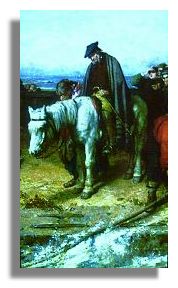
Nova Scotia was a major destination for Scottish settlers, its very name meaning 'New Scotland'. A Scottish connection with this maritime eastern Canadian province dates back to 1621 when King James VI of Scotland (King James I of England) granted a charter to the Scottish poet and statesman William Alexander (1st Earl of Stirling) for the establishment of a colony in Canada. This venture never really got off the ground owing to French rivalry and expansion in the area, which resulted in Nova Scotia being part of the French colony of Acadia for much of the 17th century. Most of Nova Scotia was finally ceded to Britain in 1713, with large-scale Scottish settlement occurring mainly during the 18th and 19th centuries due to a combination of enforced "Clearances" and economic migration. To this day, the Gaelic language and many performing arts and other Scottish customs have survived on Cape Breton Island some 250 kilometres (about 150 miles) to the north-east of Halifax.
Acknowledgments:
- Ancestry.com
- Black, George F. (1996). The Surnames of Scotland. (Edinburgh: Birlinn Ltd).
- Brown, T.J. (1922). Place-Names of the Province of Nova Scotia.
- Destination Nova Scotia
- Dictionary of Canadian Biography Online
- Halifax County GenWeb Site
- Halifax Regional Municipality Street Map, 2004 (MapArt Publishing, Oshawa).
- Scarlett, James D. (1975). The Tartans of the Scottish Clans. (Collins, Glasgow and London).
- Websites, place name gazetteers and published Ordnance Survey maps of British and Irish cities, towns, villages and counties.
- Wikipedia - Communities in the Halifax Regional Muncipality
© Ian Kendall
If you wish to contact Ian about his research, his e-mail address is ian.kendall1@bigpond.com.
Melbourne, Australia, October 2004
Revised September 2012



